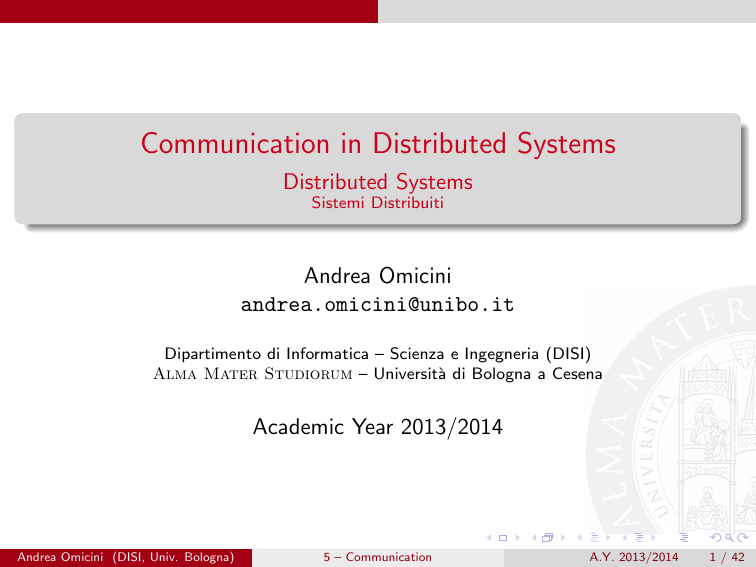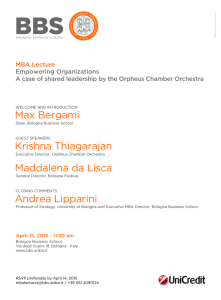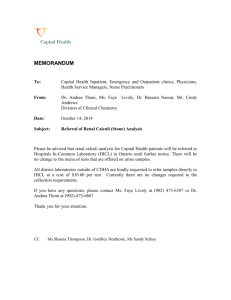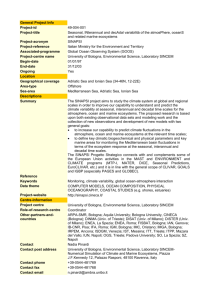
Communication in Distributed Systems
Distributed Systems
Sistemi Distribuiti
Andrea Omicini
andrea.omicini@unibo.it
Dipartimento di Informatica – Scienza e Ingegneria (DISI)
Alma Mater Studiorum – Università di Bologna a Cesena
Academic Year 2013/2014
Andrea Omicini (DISI, Univ. Bologna)
5 – Communication
A.Y. 2013/2014
1 / 42
Outline
1
Interaction & Communication
2
Fundamentals
3
Remote Procedure Call
4
Message-oriented Communication
Andrea Omicini (DISI, Univ. Bologna)
5 – Communication
A.Y. 2013/2014
2 / 42
Disclaimer
These Slides Contain Material from
[Tanenbaum and van Steen, 2007]
Slides were made kindly available by the authors of the book
Such slides shortly introduced the topics developed in the book
[Tanenbaum and van Steen, 2007] adopted here as the main book of
the course
Most of the material from those slides has been re-used in the
following, and integrated with new material according to the personal
view of the teacher of this course
Every problem or mistake contained in these slides, however, should
be attributed to the sole responsibility of the teacher of this course
Andrea Omicini (DISI, Univ. Bologna)
5 – Communication
A.Y. 2013/2014
3 / 42
Previous Knowledge
What You Are Supposed to Know. . .
. . . from the Courses of Computer Networks, Telecommunication
Networks and Foundations of Informatics
Basics about protocols
ISO/OSI
Protocols and reference model
Main network and Internet protocols
Andrea Omicini (DISI, Univ. Bologna)
5 – Communication
A.Y. 2013/2014
4 / 42
Previous Knowledge
What You Are Supposed to Know. . .
. . . from the Courses of Computer Networks, Telecommunication
Networks and Foundations of Informatics
Basics about protocols
ISO/OSI
Protocols and reference model
Main network and Internet protocols
Basics about communication
Procedure call
Representation formats and problems – e.g., little endian vs. big
endian
Sockets
Andrea Omicini (DISI, Univ. Bologna)
5 – Communication
A.Y. 2013/2014
4 / 42
Interaction & Communication
Outline
1
Interaction & Communication
2
Fundamentals
Layers & Protocols
Types of Communication
3
Remote Procedure Call
4
Message-oriented Communication
Stream-oriented Communication
Andrea Omicini (DISI, Univ. Bologna)
5 – Communication
A.Y. 2013/2014
5 / 42
Interaction & Communication
The Role of Interaction in Distributed System
Interaction vs. Computation
Talking of processes, threads, LWP, and the like, is just half of the
story
Maybe, not even the most important half. . .
→ They represent the computational components of a (distributed)
system
Components of a system actually make a system only by interacting
with each other
→ Interaction represents an orthogonal dimension with respect to
computation
Andrea Omicini (DISI, Univ. Bologna)
5 – Communication
A.Y. 2013/2014
6 / 42
Interaction & Communication
The Role of Interaction in Distributed System
Interaction vs. Computation
Talking of processes, threads, LWP, and the like, is just half of the
story
Maybe, not even the most important half. . .
→ They represent the computational components of a (distributed)
system
Components of a system actually make a system only by interacting
with each other
→ Interaction represents an orthogonal dimension with respect to
computation
Engineering Interaction
Methodologies and technologies for engineering communication are
not the same as those for engineering computation
New models and tools are required
which could be seamlessly integrated with those for engineering
computational components
Andrea Omicini (DISI, Univ. Bologna)
5 – Communication
A.Y. 2013/2014
6 / 42
Interaction & Communication
Interaction vs. Communication
Interaction is more general than communication
Communication is a form of interaction
Communication is interaction where information is exchanged
Not every interaction is communication
E.g., sharing the same space is a way of interacting without
communicating
Andrea Omicini (DISI, Univ. Bologna)
5 – Communication
A.Y. 2013/2014
7 / 42
Interaction & Communication
Interaction vs. Communication
Interaction is more general than communication
Communication is a form of interaction
Communication is interaction where information is exchanged
Not every interaction is communication
E.g., sharing the same space is a way of interacting without
communicating
Whereas such a distinction is not always evident from the literature. . .
On the one hand, we should keep this in mind
On the other hand, in the classical field of inter-process
communication, this distinction is often not essential
Andrea Omicini (DISI, Univ. Bologna)
5 – Communication
A.Y. 2013/2014
7 / 42
Interaction & Communication
Communication in Non-distributed Settings
Communication does not belong to distributed systems only
Communication mechanisms like procedure call and message-passing
just require a plurality of interacting entities, not distributed ones
However, communication in distributed systems presents more
difficult challenges, like unreliability of communication and large scale
Of course, communication in distributed systems first of all deals with
distribution / location transparency
Andrea Omicini (DISI, Univ. Bologna)
5 – Communication
A.Y. 2013/2014
8 / 42
Fundamentals
Outline
1
Interaction & Communication
2
Fundamentals
Layers & Protocols
Types of Communication
3
Remote Procedure Call
4
Message-oriented Communication
Stream-oriented Communication
Andrea Omicini (DISI, Univ. Bologna)
5 – Communication
A.Y. 2013/2014
9 / 42
Fundamentals
Layers & Protocols
Outline
1
Interaction & Communication
2
Fundamentals
Layers & Protocols
Types of Communication
3
Remote Procedure Call
4
Message-oriented Communication
Stream-oriented Communication
Andrea Omicini (DISI, Univ. Bologna)
5 – Communication
A.Y. 2013/2014
10 / 42
Fundamentals
Layers & Protocols
Layered Communication
Communication involves a number of problems at many different
levels
From the physical network level up to the application level
Communication can be organised on layers
A reference model is useful to understand how protocols, behaviours
and interactions
Andrea Omicini (DISI, Univ. Bologna)
5 – Communication
A.Y. 2013/2014
11 / 42
Fundamentals
Layers & Protocols
Layered Communication
Communication involves a number of problems at many different
levels
From the physical network level up to the application level
Communication can be organised on layers
A reference model is useful to understand how protocols, behaviours
and interactions
OSI model
Standardised by the International Standards Organization (ISO)
Designed to allow open systems to communicate
Rules for communication govern the format, content and meaning of
messages sent and received
Such rules are formalised in protocols
The collection of protocols for a particular system is its protocol
stack, or protocol suite
Andrea Omicini (DISI, Univ. Bologna)
5 – Communication
A.Y. 2013/2014
11 / 42
Fundamentals
Layers & Protocols
Types of Protocols
Connection-oriented protocols
First of all, a connection is established between the sender and the
receiver
Possibly, an agreement over the protocol to be used is reached
Then, communication occurs through the connection
Finally, the connection is terminated
Andrea Omicini (DISI, Univ. Bologna)
5 – Communication
A.Y. 2013/2014
12 / 42
Fundamentals
Layers & Protocols
Types of Protocols
Connection-oriented protocols
First of all, a connection is established between the sender and the
receiver
Possibly, an agreement over the protocol to be used is reached
Then, communication occurs through the connection
Finally, the connection is terminated
Connectionless protocols
No setup is required
The sender just send a message when it is ready
Andrea Omicini (DISI, Univ. Bologna)
5 – Communication
A.Y. 2013/2014
12 / 42
Fundamentals
Layers & Protocols
The OSI Reference Model
Layers, interfaces, and protocols in the OSI Model
[Tanenbaum and van Steen, 2007]
Andrea Omicini (DISI, Univ. Bologna)
5 – Communication
A.Y. 2013/2014
13 / 42
Fundamentals
Layers & Protocols
A Message in the OSI Reference Model
A typical message as it appears on the network
[Tanenbaum and van Steen, 2007]
Andrea Omicini (DISI, Univ. Bologna)
5 – Communication
A.Y. 2013/2014
14 / 42
Fundamentals
Layers & Protocols
OSI Model 6= OSI Protocols
OSI protocols
Never successful
TCP/IP is not an OSI protocol, and still dominates its layers
Andrea Omicini (DISI, Univ. Bologna)
5 – Communication
A.Y. 2013/2014
15 / 42
Fundamentals
Layers & Protocols
OSI Model 6= OSI Protocols
OSI protocols
Never successful
TCP/IP is not an OSI protocol, and still dominates its layers
OSI model
Perfect to understand and describe communication systems through
layers
However, some problems exist when middleware comes to play
Andrea Omicini (DISI, Univ. Bologna)
5 – Communication
A.Y. 2013/2014
15 / 42
Fundamentals
Layers & Protocols
Middleware Protocols
The problem
Middleware mostly lives at the application level
Protocols for middleware services are different from high-level
application protocols
← Middleware protocols are application-independent, application
protocols are obviously application-dependent
How can we distinguish between the two sorts of protocols at the
same layer?
Andrea Omicini (DISI, Univ. Bologna)
5 – Communication
A.Y. 2013/2014
16 / 42
Fundamentals
Layers & Protocols
Middleware Protocols
The problem
Middleware mostly lives at the application level
Protocols for middleware services are different from high-level
application protocols
← Middleware protocols are application-independent, application
protocols are obviously application-dependent
How can we distinguish between the two sorts of protocols at the
same layer?
Extending the reference model for middleware
Session and presentation layers are replaced by a middleware layer ,
which includes all application-independent protocols
Potentially, also the transport layer could be offered in the middleware
one
Andrea Omicini (DISI, Univ. Bologna)
5 – Communication
A.Y. 2013/2014
16 / 42
Fundamentals
Layers & Protocols
Middleware as an Additional Service in Client-Server
Computing
Adapted reference model for network communication
[Tanenbaum and van Steen, 2007]
Andrea Omicini (DISI, Univ. Bologna)
5 – Communication
A.Y. 2013/2014
17 / 42
Fundamentals
Types of Communication
Outline
1
Interaction & Communication
2
Fundamentals
Layers & Protocols
Types of Communication
3
Remote Procedure Call
4
Message-oriented Communication
Stream-oriented Communication
Andrea Omicini (DISI, Univ. Bologna)
5 – Communication
A.Y. 2013/2014
18 / 42
Fundamentals
Types of Communication
Types of Communication
Persistent vs. transient communication
Persistent communication — A message sent is stored by the
communication middleware until it is delivered to the receiver
→ No need for time coupling between the sender and the receiver
Transient communication — A message sent is stored by the
communication middleware only as long as both the receiver and the
sender are executing
→ Time coupling between the sender and the receiver
Andrea Omicini (DISI, Univ. Bologna)
5 – Communication
A.Y. 2013/2014
19 / 42
Fundamentals
Types of Communication
Types of Communication
Persistent vs. transient communication
Persistent communication — A message sent is stored by the
communication middleware until it is delivered to the receiver
→ No need for time coupling between the sender and the receiver
Transient communication — A message sent is stored by the
communication middleware only as long as both the receiver and the
sender are executing
→ Time coupling between the sender and the receiver
Asynchronous vs. synchronous communication
Asynchronous communication — The sender keeps on executing after
sending a message
→ The message should be stored by the middleware
Synchronous communication — The sender blocks execution after
sending a message and waits for response – until the middleware
acknowledges trasmission, or, until the receiver acknowledges the
reception, or, until the receiver has completed processing the request
→ Some form of coupling in control between the sender and the receiver
Andrea Omicini (DISI, Univ. Bologna)
5 – Communication
A.Y. 2013/2014
19 / 42
Fundamentals
Types of Communication
Communications with a Middleware Layer
Viewing middleware as an intermediate (distributed) service in
application-level communication
[Tanenbaum and van Steen, 2007]
Andrea Omicini (DISI, Univ. Bologna)
5 – Communication
A.Y. 2013/2014
20 / 42
Fundamentals
Types of Communication
Actual Communication in Distributed Systems
Persistency & synchronisation in communication
In the practice of distributed systems, many combinations of persistency and
synchronisation are typically adopted
Persistency and synchronisation should then be taken as two dimensions along which
communication and protocols could be analysed and classified
Andrea Omicini (DISI, Univ. Bologna)
5 – Communication
A.Y. 2013/2014
21 / 42
Fundamentals
Types of Communication
Actual Communication in Distributed Systems
Persistency & synchronisation in communication
In the practice of distributed systems, many combinations of persistency and
synchronisation are typically adopted
Persistency and synchronisation should then be taken as two dimensions along which
communication and protocols could be analysed and classified
Discrete vs. streaming communication
Communication is not always discrete, that is, it does not always happen through
complete units of information – e.g., messages
Discrete communication is then quite common, but not the only way available – and
does not respond to all the needs
Sometimes, communication needs to be continuous – through sequences of messages
constituting a possibly unlimited amount of information
Streaming communication — The sender delivers a (either limited or unlimited)
sequence of messages representing the stream of information to be sent to the receiver
→ Communication may be continuous
Andrea Omicini (DISI, Univ. Bologna)
5 – Communication
A.Y. 2013/2014
21 / 42
Remote Procedure Call
Outline
1
Interaction & Communication
2
Fundamentals
Layers & Protocols
Types of Communication
3
Remote Procedure Call
4
Message-oriented Communication
Stream-oriented Communication
Andrea Omicini (DISI, Univ. Bologna)
5 – Communication
A.Y. 2013/2014
22 / 42
Remote Procedure Call
Remote Procedure Call (RPC)
Basic idea
Programs can call procedures on other machines
When a process A calls a procedure on a machine B, A is suspended,
and execution of procedure takes place on B
Once the procedure execution has been completed, its completion is
sent back to A, which resumes execution
Andrea Omicini (DISI, Univ. Bologna)
5 – Communication
A.Y. 2013/2014
23 / 42
Remote Procedure Call
Remote Procedure Call (RPC)
Basic idea
Programs can call procedures on other machines
When a process A calls a procedure on a machine B, A is suspended,
and execution of procedure takes place on B
Once the procedure execution has been completed, its completion is
sent back to A, which resumes execution
Information in RPC
Information is not sent directly from sender to receiver
Parameters are just packed and transmitted along with the request
Procedure results are sent back with the completion
No message passing
Andrea Omicini (DISI, Univ. Bologna)
5 – Communication
A.Y. 2013/2014
23 / 42
Remote Procedure Call
Issues of RPC
Main problems
The address space of the caller and the callee are separate and
different
→ Need for a common reference space
Parameters and results have to be passed and handled correctly
→ Need for a common data format
Either / both machines could unexpectedly crash
→ Need for suitable fault-tolerance policies
Andrea Omicini (DISI, Univ. Bologna)
5 – Communication
A.Y. 2013/2014
24 / 42
Remote Procedure Call
Conventional Procedure Call
Parameter passing in a local procedure call
[Tanenbaum and van Steen, 2007]
Andrea Omicini (DISI, Univ. Bologna)
5 – Communication
A.Y. 2013/2014
25 / 42
Remote Procedure Call
Client & Server Stubs
Main goal: transparency
RPC should be like local procedure call from the viewpoint of both
the caller and the callee
→ Procedure calls are sent to the client stub and transmitted to the
server stub through the network to the called procedure
Principle of RPC between a client and server program
[Tanenbaum and van Steen, 2007]
Andrea Omicini (DISI, Univ. Bologna)
5 – Communication
A.Y. 2013/2014
26 / 42
Remote Procedure Call
Steps for a RPC
The client procedure calls the client stub in the normal way
Andrea Omicini (DISI, Univ. Bologna)
5 – Communication
A.Y. 2013/2014
27 / 42
Remote Procedure Call
Steps for a RPC
The client procedure calls the client stub in the normal way
The client stub builds a message and calls the local operating system
Andrea Omicini (DISI, Univ. Bologna)
5 – Communication
A.Y. 2013/2014
27 / 42
Remote Procedure Call
Steps for a RPC
The client procedure calls the client stub in the normal way
The client stub builds a message and calls the local operating system
The client’s OS sends the message to the remote OS
Andrea Omicini (DISI, Univ. Bologna)
5 – Communication
A.Y. 2013/2014
27 / 42
Remote Procedure Call
Steps for a RPC
The client procedure calls the client stub in the normal way
The client stub builds a message and calls the local operating system
The client’s OS sends the message to the remote OS
The remote OS gives the message to the server stub
Andrea Omicini (DISI, Univ. Bologna)
5 – Communication
A.Y. 2013/2014
27 / 42
Remote Procedure Call
Steps for a RPC
The client procedure calls the client stub in the normal way
The client stub builds a message and calls the local operating system
The client’s OS sends the message to the remote OS
The remote OS gives the message to the server stub
The server stub unpacks the parameters and calls the server
Andrea Omicini (DISI, Univ. Bologna)
5 – Communication
A.Y. 2013/2014
27 / 42
Remote Procedure Call
Steps for a RPC
The client procedure calls the client stub in the normal way
The client stub builds a message and calls the local operating system
The client’s OS sends the message to the remote OS
The remote OS gives the message to the server stub
The server stub unpacks the parameters and calls the server
The server does the work and returns the result to the stub
Andrea Omicini (DISI, Univ. Bologna)
5 – Communication
A.Y. 2013/2014
27 / 42
Remote Procedure Call
Steps for a RPC
The client procedure calls the client stub in the normal way
The client stub builds a message and calls the local operating system
The client’s OS sends the message to the remote OS
The remote OS gives the message to the server stub
The server stub unpacks the parameters and calls the server
The server does the work and returns the result to the stub
The server stub packs it in a message and calls its local OS
Andrea Omicini (DISI, Univ. Bologna)
5 – Communication
A.Y. 2013/2014
27 / 42
Remote Procedure Call
Steps for a RPC
The client procedure calls the client stub in the normal way
The client stub builds a message and calls the local operating system
The client’s OS sends the message to the remote OS
The remote OS gives the message to the server stub
The server stub unpacks the parameters and calls the server
The server does the work and returns the result to the stub
The server stub packs it in a message and calls its local OS
The server’s OS sends the message to the client’s OS
Andrea Omicini (DISI, Univ. Bologna)
5 – Communication
A.Y. 2013/2014
27 / 42
Remote Procedure Call
Steps for a RPC
The client procedure calls the client stub in the normal way
The client stub builds a message and calls the local operating system
The client’s OS sends the message to the remote OS
The remote OS gives the message to the server stub
The server stub unpacks the parameters and calls the server
The server does the work and returns the result to the stub
The server stub packs it in a message and calls its local OS
The server’s OS sends the message to the client’s OS
The client’s OS gives the message to the client stub
Andrea Omicini (DISI, Univ. Bologna)
5 – Communication
A.Y. 2013/2014
27 / 42
Remote Procedure Call
Steps for a RPC
The client procedure calls the client stub in the normal way
The client stub builds a message and calls the local operating system
The client’s OS sends the message to the remote OS
The remote OS gives the message to the server stub
The server stub unpacks the parameters and calls the server
The server does the work and returns the result to the stub
The server stub packs it in a message and calls its local OS
The server’s OS sends the message to the client’s OS
The client’s OS gives the message to the client stub
The stub unpacks the result and returns to the client
Andrea Omicini (DISI, Univ. Bologna)
5 – Communication
A.Y. 2013/2014
27 / 42
Remote Procedure Call
Parameter Passing
Passing value parameters
Parameters are marshalled to pass across the network
→ Procedure calls are sent to the client stub and transmitted to the
server stub through the network to the called procedure
Steps of a remote computation through a RPC
[Tanenbaum and van Steen, 2007]
Andrea Omicini (DISI, Univ. Bologna)
5 – Communication
A.Y. 2013/2014
28 / 42
Remote Procedure Call
Issues in Parameter Passing
Passing value parameters
Problems of representation and meaning
E.g., little endian vs. big endian
In order to ensure transparency, stubs should be in charge of the mapping & translation
Possible approach: interfaces described through and IDL (Interface Definition
Language), and consequent handling compiled into the stubs
Andrea Omicini (DISI, Univ. Bologna)
5 – Communication
A.Y. 2013/2014
29 / 42
Remote Procedure Call
Issues in Parameter Passing
Passing value parameters
Problems of representation and meaning
E.g., little endian vs. big endian
In order to ensure transparency, stubs should be in charge of the mapping & translation
Possible approach: interfaces described through and IDL (Interface Definition
Language), and consequent handling compiled into the stubs
Passing reference parameters
Main problem: reference space is local
First solution: forbidding reference parameters
Second solution: copying parameters (suitably updating the reference), then copying
them back (according to the original reference)
→ Call-by-reference becomes copy&restore
Third solution: creating a global/accessible reference to the caller space from the callee
Andrea Omicini (DISI, Univ. Bologna)
5 – Communication
A.Y. 2013/2014
29 / 42
Remote Procedure Call
Asynchronous RPC
Synchronicity might be a problem in distributed systems
Synchronicity is often unnecessary, and may create problems
→ Asynchronous RPC is an available alternative in many situations
Asynchronous RPC
Traditional RPC
[Tanenbaum and van Steen, 2007]
Andrea Omicini (DISI, Univ. Bologna)
5 – Communication
A.Y. 2013/2014
30 / 42
Remote Procedure Call
Deferred Synchronous RPC
Combining asynchronous RPCs
Sometimes some synchronicity is required, but too much is too much
→ Deferred Synchronous RPC combines two asynchronous RPC to
provide an ad hoc form of synchronicity
The first asynchronous call selects the procedure to be executed and
provides for the parameters
The second asynchronous call goes for the results
In between, the caller may keep on computing
Andrea Omicini (DISI, Univ. Bologna)
5 – Communication
A.Y. 2013/2014
31 / 42
Remote Procedure Call
Limits of RPC
Coupling in time
Co-existence in time is a requirement for any RPC mechanism
Sometimes, a too-hard requirement for effective communication in
distributed systems
An alternative is required that does not require the receiver to be
executing when the message is sent
Andrea Omicini (DISI, Univ. Bologna)
5 – Communication
A.Y. 2013/2014
32 / 42
Remote Procedure Call
Limits of RPC
Coupling in time
Co-existence in time is a requirement for any RPC mechanism
Sometimes, a too-hard requirement for effective communication in
distributed systems
An alternative is required that does not require the receiver to be
executing when the message is sent
The alternative: messaging
Please notice: message-oriented communication is not synonym of
uncoupling
However, we can take this road toward uncoupled communication
Andrea Omicini (DISI, Univ. Bologna)
5 – Communication
A.Y. 2013/2014
32 / 42
Message-oriented Communication
Outline
1
Interaction & Communication
2
Fundamentals
Layers & Protocols
Types of Communication
3
Remote Procedure Call
4
Message-oriented Communication
Stream-oriented Communication
Andrea Omicini (DISI, Univ. Bologna)
5 – Communication
A.Y. 2013/2014
33 / 42
Message-oriented Communication
Message-oriented Transient Communication
Basic idea
Messages are sent through a channel abstraction
The channel connects two running processes
Time coupling between sender and receiver
Transmission time is measured in terms of milliseconds, typically
Andrea Omicini (DISI, Univ. Bologna)
5 – Communication
A.Y. 2013/2014
34 / 42
Message-oriented Communication
Message-oriented Transient Communication
Basic idea
Messages are sent through a channel abstraction
The channel connects two running processes
Time coupling between sender and receiver
Transmission time is measured in terms of milliseconds, typically
Examples
Berkeley Sockets — typical in TCP/IP-based networks
MPI (Message-Passing Interface) — typical in high-speed
interconnection networks among parallel processes
Andrea Omicini (DISI, Univ. Bologna)
5 – Communication
A.Y. 2013/2014
34 / 42
Message-oriented Communication
Message-Oriented Persistent Communication
Message-queuing systems – a.k.a. Message-Oriented Middleware
(MOM)
Basic idea: MOM provides message storage service
A message is put in a queue by the sender, and delivered to a
destination queue
The target(s) can retrieve their messages from the queue
Time uncoupling between sender and receiver
Example: IBM’s WebSphere
General architecture of a message-queuing system
[Tanenbaum and van Steen, 2007]
Andrea Omicini (DISI, Univ. Bologna)
5 – Communication
A.Y. 2013/2014
35 / 42
Message-oriented Communication
Stream-oriented Communication
Outline
1
Interaction & Communication
2
Fundamentals
Layers & Protocols
Types of Communication
3
Remote Procedure Call
4
Message-oriented Communication
Stream-oriented Communication
Andrea Omicini (DISI, Univ. Bologna)
5 – Communication
A.Y. 2013/2014
36 / 42
Message-oriented Communication
Stream-oriented Communication
Streams
Sequences of data
A stream is transmitted by sending sequences of related messages
Single vs. complex streams: a single sequence vs. several related
simple streams
Data streams: typically, streams are used to represent and transmit
huge amounts of data
Examples: JPEG images, MPEG movies
Andrea Omicini (DISI, Univ. Bologna)
5 – Communication
A.Y. 2013/2014
37 / 42
Message-oriented Communication
Stream-oriented Communication
Streams & Time
Continuous vs. discrete media
In the case of continuous (representation) media, time is relevant to
understand the data – e.g., audio streams
In the case of discrete (representation) media, time is not relevant to
understand the data – e.g., still images
Andrea Omicini (DISI, Univ. Bologna)
5 – Communication
A.Y. 2013/2014
38 / 42
Message-oriented Communication
Stream-oriented Communication
Streams & Time
Continuous vs. discrete media
In the case of continuous (representation) media, time is relevant to
understand the data – e.g., audio streams
In the case of discrete (representation) media, time is not relevant to
understand the data – e.g., still images
Transmission of time-dependent information
Asynchronous transmission mode data items of a stream are transmitted
in sequence without further constraints—e.g., a file
representing a still image
Synchronous transmission mode data items of a stream are transmitted in
sequence with a maximum end-to-end delay—e.g., data
generation by a pro-active sensor
Isochronous transmission mode data items of a stream are transmitted in
sequence with both a maximum and a minimum end-to-end
delay—e.g., audio & video
Andrea Omicini (DISI, Univ. Bologna)
5 – Communication
A.Y. 2013/2014
38 / 42
Message-oriented Communication
Stream-oriented Communication
Streams & Quality of Service
Quality of service
Timing and other non-functional properties are typically expressed as
Quality of Service (QoS) requirements
In the case of streams, QoS typically concerns timing , volume, and
reliability
In the case of middleware, the issue is how can a given middleware
ensure QoS to distributed applications
Andrea Omicini (DISI, Univ. Bologna)
5 – Communication
A.Y. 2013/2014
39 / 42
Message-oriented Communication
Stream-oriented Communication
Streams & Quality of Service
Quality of service
Timing and other non-functional properties are typically expressed as
Quality of Service (QoS) requirements
In the case of streams, QoS typically concerns timing , volume, and
reliability
In the case of middleware, the issue is how can a given middleware
ensure QoS to distributed applications
A practical problem
Whatever the theory, many distributed systems providing streaming
services rely on top of the IP stack
IP specification allow for a protocol implementation dropping packets
when needed
QoS should be enforced at the higher levels
Andrea Omicini (DISI, Univ. Bologna)
5 – Communication
A.Y. 2013/2014
39 / 42
Conclusions
Summing Up
Interaction & communication
Interaction as an orthogonal dimension w.r.t. computation
Communication as a form of interaction
Andrea Omicini (DISI, Univ. Bologna)
5 – Communication
A.Y. 2013/2014
40 / 42
Conclusions
Summing Up
Interaction & communication
Interaction as an orthogonal dimension w.r.t. computation
Communication as a form of interaction
High-level abstractions for process-level communication
Remote Procedure Call
Message-oriented models
Streaming
Other forms like multicasting and epidemic protocols are important,
but are not a subject for this course
Andrea Omicini (DISI, Univ. Bologna)
5 – Communication
A.Y. 2013/2014
40 / 42
References
References I
Tanenbaum, A. S. and van Steen, M. (2007).
Distributed Systems. Principles and Paradigms.
Pearson Prentice Hall, Upper Saddle River, NJ, USA, 2nd edition.
Andrea Omicini (DISI, Univ. Bologna)
5 – Communication
A.Y. 2013/2014
41 / 42
Communication in Distributed Systems
Distributed Systems
Sistemi Distribuiti
Andrea Omicini
andrea.omicini@unibo.it
Dipartimento di Informatica – Scienza e Ingegneria (DISI)
Alma Mater Studiorum – Università di Bologna a Cesena
Academic Year 2013/2014
Andrea Omicini (DISI, Univ. Bologna)
5 – Communication
A.Y. 2013/2014
42 / 42






